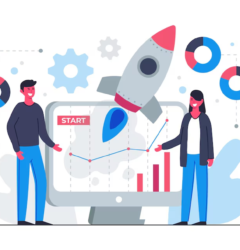10 Oct

Staying Ahead Of The Curve: How To Adapt To Rapidly Changing Technologies
In the 21st century, the importance of adapting to new technology cannot be ignored because these technologies drive your business growth, enhance operational efficiency, and meet evolving market demands. Are you keeping up with the rapidly changing technology, or is your business lagging? Do you know how to integrate these advancements effectively into your operations?
Recognizing technological shifts and implementing new tools strategically is key. Stay ahead by prioritizing continuous learning, fostering innovation, and experimenting with emerging technologies. Stay tuned to learn how to leverage these advancements and thrive.
Stay tuned to explore further ways to integrate adaptive technologies into a business and many others.
Why Adapting To New Technology Matters: Impact And Importance
Adaptive technologies are tools and systems designed to adjust and tailor solutions to individual needs or changing circumstances, enhancing productivity and accessibility. Examples include assistive devices for disabilities and personalized learning or work tools.
Below are examples to help you understand how technology creates wonder and helps a business to be a leader in the market.
Embracing Technology
For businesses, HR, and EOR services, these technologies contribute to relieving the time for tasks, enhancing the decision-making process, and obtaining insights on the state and necessity of the workforce. For example, recruitment can be automated, and the right candidates are hired in the shortest time possible and most efficiently.
The Role Of Data And Cloud Technologies
A major advantage of cloud-based solutions is that they offer more versatile and efficient approaches to solving HR problems, making it easier for a company to run a global workforce.
Data analytics enables companies to understand their employees’ performance, engagement, and turnover and make the right choices to optimize organizational efficiency. Considering this importance, within the next 5 years, 75% of companies plan to integrate AI technology, big data, and cloud computing into their operation.
Similarly, many other fields, such as healthcare, education, and finance, embrace new technologies to stay competitive and improve their services.
Necessity For Change: Navigating the Future Of Business
There are several reasons behind embracing adaptive technologies:
Evolving Client Expectations
First, the expectations of clients are constantly evolving, and to meet their needs, companies are forced to improve and develop their services and products. As business organizations embrace technology in their operations and models, the same is demanded from service providers.
This means that HR and EOR companies must be able to provide the best technologies for their clients to address their requirements.
Increased Competition
Any organization incorporating and implementing new technologies when producing goods has comparative advantages over its counterparts.
This is particularly apparent in the manufacturing context, where automation and advanced robotic technologies become an organization’s competitive edge through which they can improve production, productivity, and quality.
Dynamic Regulatory Constraints
Last but not least, regulatory constraints remain dynamic as laws and regulations evolve. Technological solutions can assist organizations with compliance through payroll processing, benefits management, or tax procedures, eliminating the chances of violations.
Strategies for Adapting to Rapidly Changing Technology
When companies adapt to rapid change in technology, it helps them ensure their employees remain updated and competitive.
Below are some strategies to help companies elevate their business to the next level.
Continuous Learning and Development
With technological advancement, it becomes important for any organization to think of how people can be built for the future. This entails providing the human resource staff with periodic training programs or sessions that bring new tools and concepts in human resource management into the organization.
Encouraging Certification and Courses
Another solution is advising team members to take certifications and courses in new and trending technologies. It helps to create a positive organizational culture where all members feel motivated to learn new things.
Leveraging Data Analytics
Technology is recognized as the key success factor that, if managed properly, can enhance the decision-making process in organizations.
Companies can use data on how well employees perform, how engaged they are, and how satisfied they feel to understand how technology impacts their workforce. This knowledge also becomes useful in trending bends, essential in alerting organizations and enabling them to embrace new technologies.
Partnering with Technology Providers
Working with technology partners can make it easier for firms to access modern equipment and technology. Such partnerships can also help companies gain the support they need to successfully deploy new technologies, ensuring they select only the best solutions for their businesses. Certainly, it is an ideal way to stay one step ahead to the market.
Fostering A Culture Of Innovation
Promoting the culture of innovation in your team is a great way to match the pace of technology. Every worker should be encouraged to seek out new technologies and ideas and provide input on optimizing processes.
By supporting a company’s culture of innovation, the organization also makes sure that it is way ahead of the other companies, and embracing innovation is a key consideration.
Staying Informed
When a company is launching new products or services, it is crucial to stay updated with current technology to stay caught up and stay relevant in the market.
For this purpose, organizations should follow relevant articles and journals, attend events or webinars, and engage in industry newsletters. Becoming a professional organization member can also inform companies about current trends and best practices.
Eventually, it helps them learn how to use new technology and integrate it into their business effectively.
Overcoming Challenges in Adapting to New Technology
There are numerous advantages to making changes to align with new technology, but some drawbacks are worth noting:
- New technologies may need fixing with existing systems. Ensure smooth integration by assessing compatibility and investing in necessary updates.
- Implementing new technology can introduce security vulnerabilities. Address these by investing in robust cybersecurity measures and regular system audits.
- The current workforce may lack the necessary skills to operate new technologies. Provide upskilling opportunities and recruit talent with the required expertise.
- Managing the transition process can be complex and time-consuming. Develop a structured change management plan to guide the adoption process effectively.
Final Words
Companies must emphasize the importance of adaptive technologies today, especially as they permeate more aspects of the business world. Implementing innovative solutions has become crucial to remaining an industry player and leader.
That is why flexibility and effective regulation of technological changes are the key to success in the digital age. For this, companies need to stay informed about the advancements.
Are you ready to turn your business into the digital era with the latest technology? Ready to streamline your HR and operations without setting up a legal entity?
Contact Avyenter today to discover how our specialized services can help you efficiently manage payroll, recruitment, and IT assets. Let us provide the seamless solutions you need to stay ahead in the digital landscape. Reach out now and elevate your business with our expert support!
